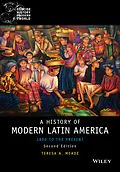Now available in a fully-revised and updated second edition, A History of Modern Latin America offers a comprehensive and accessible introduction to the rich cultural and political history of this vibrant region from the onset of independence to the present day.
* Includes coverage of the recent opening of diplomatic relations between the U.S. and Cuba as well as a new chapter exploring economic growth and environmental sustainability
* Balances accounts of the lives of prominent figures with those of ordinary people from a diverse array of social, racial, and ethnic backgrounds
* Features first-hand accounts, documents, and excerpts from fiction interspersed throughout the narrative to provide tangible examples of historical ideas
* Examines gender and its influence on political and economic change and the important role of popular culture, including music, art, sports, and movies, in the formation of Latin American cultural identity
* Includes all-new study questions and topics for discussion at the end of each chapter, plus comprehensive updates to the suggested readings
Autorentext
Teresa Meade is Florence B. Sherwood Professor of History and Culture at Union College, New York. She is the author of A Brief History of Brazil (2nd edition, 2009), “Civilizing” Rio: Reform and Resistance in a Brazilian City (2005), and co-editor of A Companion to Gender History (Wiley, 2004) and Science, Medicine and Cultural Imperialism (1991). She has written widely on Latin America as well as on women and gender history.
Zusammenfassung
Now available in a fully-revised and updated second edition, A History of Modern Latin America offers a comprehensive and accessible introduction to the rich cultural and political history of this vibrant region from the onset of independence to the present day.
- Includes coverage of the recent opening of diplomatic relations between the U.S. and Cuba as well as a new chapter exploring economic growth and environmental sustainability
- Balances accounts of the lives of prominent figures with those of ordinary people from a diverse array of social, racial, and ethnic backgrounds
- Features first-hand accounts, documents, and excerpts from fiction interspersed throughout the narrative to provide tangible examples of historical ideas
- Examines gender and its influence on political and economic change and the important role of popular culture, including music, art, sports, and movies, in the formation of Latin American cultural identityÂ
- Includes all-new study questions and topics for discussion at the end of each chapter, plus comprehensive updates to the suggested readings
Inhalt
Preface to the Second Edition xiii
Acknowledgments xvii
1 Introduction to the Land and Its People 1
Geography 2
People 2
Economies 7
Politics 8
Culture and Entertainment 13
Latin America: Past and Present 22
Topics and Questions for Discussion 23
2 Latin America in 1790 24
Colonial Background 25
Power and Privilege 29
Wealth 30
Colonial Administration 34
Enlightened Monarchy 36
The Agents of the Reform 37
Disorder and Rebellion 39
Discontent and Disorder in Brazil 41
Changing Gender Roles 42
On the Road to Independence 44
Nationalism and American Culture 44
Conclusion 49
Topics and Questions for Discussion 49
3 Competing Notions of Freedom 51
Five Roads to Independence 52
African Slavery in the Americas 53
Slavery and the Countryside 57
Slavery in the Cities 58
Treatment and Punishment 60
Slavery and the Church 60
African Medicine and Religious Practices 61
Resistance and Rebellion 63
The Sugar Colony of Saint-Domingue 65
The Slave Revolt 66
The Revolution Betrayed 68
Brazil’s Independent Empire 69
Independence in Mexico 71
South American Independence 73
Post-independence Changes in Racial and Gender Status 77
The Last Holdout of Slavery in Spanish America 78
Latin America in a ChangingWorld Order 80
Conclusion 81
Topics and Questions for Discussion 82
4 Fragmented Nationalisms 84
Searching for Political and Economic Unity 84
NewWorld “Feudalism” 86
Post-independence Politics 90
Argentina and the Tyrants 92
Populist Caudillismo: Paraguay and Bolivia 93
After Caudillismo 96
Race, Race Mixture, and Liberalism 97
Gender and Liberalism 100
Intersections of Gender, Race, and Class 103
Nationalism 105
Conclusion 108
Topics and Questions for Discussion 108
5 Latin America’s Place in the Commodity Chain 110
The Guano Boom 111
Nitrates in Chile 113
The Growth of S˜ao Paulo 116
Colombian Coffee 118
The Rubber Boom 119
Expanding Exports 121
Mexico and US Expansionism 122
The North American Invasion 124
General L´opez de Santa Anna 126
The New Age of Imperialism 127
Central America and the Panama Canal 128
Ecuador and the “Panama” Hat 130
Independence at Last? Cuba and Puerto Rico 131
Conclusion 138
Topics and Questions for Discussion 138
6 Immigration, and Urban and Rural Life 140
Asian Immigration 141
European Immigration 142
The Southern Cone 144
Life on the Pampas 146
British Investment 148
The Changing Cultural Landscape 149
Urban Renewal 152
Mexico and Benito Ju´arez 154
French Invasions 155
The Rise of Porfirio D´yaz 156
Intellectual Theories: Positivism and Eugenics 157
Conclusion 159
Topics and Questions for Discussion 160
7 Revolution from Countryside to City: Mexico 161
The Porfiriato 162
Opposition to the Porfiriato 164
Constitutional Opposition 165
Madero Assassinated 167
US Intervention 168
Women in Combat 169
Carranza as President 170
The Constitution of 1917 171
Aftermath of Struggle 174
Agrarian Revolts in Latin America 175
Conclusion 1...
